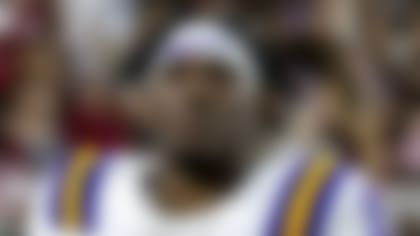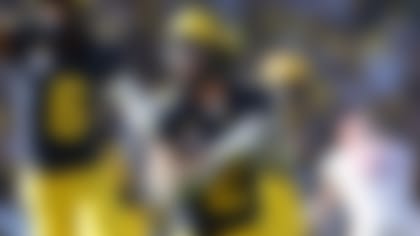Finding the perfect quarterback.
It's the dream of every NFL coach and executive. Of course, it can seem like an impossible one, given how rarely guys like Aaron Rodgers, Andrew Luck and Russell Wilson come along. But what if, rather than hoping to discover a gem, you could engineer one in the lab, blending together the best traits of the league's best signal-callers to create an unbeatable player at the game's most important position?
Two weeks ago, I attempted to build the perfect receiver, combining the most important attributes of the top receivers around the NFL to construct the ultimate pass-catching machine. Inspired by the results, I set out to make the perfect quarterback.
Note that the attributes I chose for this exercise are those that are crucial to determining quarterback success. In other words, when you look for quarterback potential in real life, these are the traits you're hoping to find.
The perfect quarterback would have ...
... the accuracy of Aaron Rodgers.
Accuracy is the most important trait for a quarterback, as it directly impacts his ability to perform the central function of his job: getting the ball in his receivers' hands. Rodgers is one of the most accurate in the NFL. The reigning NFL MVP -- who didn't throw an interception in a single Packers home game last season, including the playoffs -- can fit passes into tight windows; he has the velocity and touch to get the ball exactly where he wants it. Consider that he managed to complete nearly 70 percent of his passes in the Divisional Round win over the Cowboys, despite the fact he was practically standing on one leg for much of it. Classic example: Troy Aikman.
... the toughness of Ben Roethlisberger.
You want someone who can stand right in there, knowing the blitz is coming -- knowing he's not likely to escape unscathed -- and still concentrate on making his throw without flinching. You want someone who will take a solid hit and get right back up to make a big play on the next snap. How many times have we seen Roethlisberger do exactly that in his long career leading the Steelers? Classic example: Roger Staubach.
... the mental quickness of Peyton Manning.
Every quarterback who started in the NFL last season is smart; to truly gain an advantage, you need someone who's brilliant. Manning knows where everyone on the field is at all times. His ability to read opposing defenses is unparalleled. The veteran Broncos signal-caller goes through his reads and progressions with lightning speed and knows how to make the right decision quickly. He doesn't try to force balls where they shouldn't go. He also knows how to make sure the play called is the one that gives the offense the best chance to succeed. Classic example: Steve Young.
... the leadership ability of Tom Brady.
This can be difficult to quantify, but you want the ideal quarterback to have the respect of his teammates, having proven himself to be someone who can carry the offense when necessary. Brady did that with his first season as a starter in New England and has since cemented himself as one of the best in this category. Of course, the more you win, the more effective you are as a leader. Some might wonder if the ball-deflation scandal will hamper Brady's ability to lead, but I don't see that as a factor; players in a locker room have a special bond, and they won't be affected by that at all. Classic example: Lynn Dickey.
... the athleticism of Cam Newton.
Athletic quarterbacks make life tough for opposing defenses in multiple ways. Not only are they difficult to bring down (behind the line of scrimmage or otherwise), but they often command the attention of a designated spy, leaving one less defender in coverage. Between his imposing size (6-foot-5, 245 pounds) and overall athletic ability, the Panthers star presents a daunting challenge even when he's not running with the ball in his hands. Of course, he's also plenty daunting when he does take off, given that he's averaging 5.5 yards per carry in his career. Classic example: Brett Favre.
... the touch of Drew Brees.
You can throw the hardest fastball in the world, but if you can't command or control it, you're not getting anywhere as a pitcher. Similarly, quarterbacks need to be able to throw with touch. As he's demonstrated over the years with the Saints, Brees can deliver the ball with ample velocity when the situation calls for it. BUT he can also take something off of it when needed, in order to place the ball in the exact right spot for the receiver to make a play. Classic example: Joe Montana.
... the arm of Matthew Stafford.
Arm strength is not something you draft for, because the other elements of quarterback play discussed here are so much more significant. But as long as we're dreaming about the perfect quarterback, let's give our guy the rifle of Stafford. If you're looking for the player who has the strongest arm and can throw the ball the farthest, the Lions' signal-caller is who you're looking for. If he could combine that arm with some touch, he'd be tough to beat. Classic example: John Elway.
... the running ability of Russell Wilson.
Wilson excels at several other categories, including leadership, toughness and competitiveness, which makes his running ability all the more dangerous. When he drops back to pass and everyone's covered, he can take off; he's also quite effective on planned runs. Consider the havoc the Seahawks quarterback wreaked with his legs in 2014, putting up 849 yards on 119 carries -- the fourth-most ever in a season by a quarterback to attempt 300 or more passes. Classic example: Fran Tarkenton.
... the competitiveness of Andrew Luck.
Luck simply cannot be counted out -- ever. This guy's mounted a lot of late-game wins (nine fourth-quarter comebacks and 12 game-winning drives) in his three-year career. Think of the furious rally he sparked in the Colts' shootout win over the Chiefs in the 2013 playoffs. His all-around quarterbacking abilities -- the threat that he can beat you through the air or on the ground -- make him tough to contain when he gets on a roll. Classic example: Dan Fouts.
Follow Gil Brandt on Twitter _@GilBrandt_.













